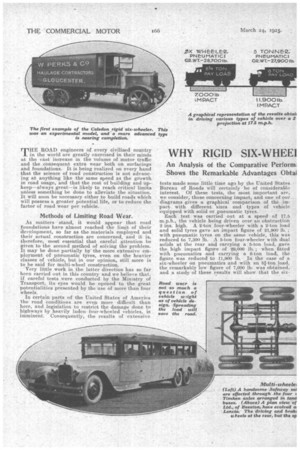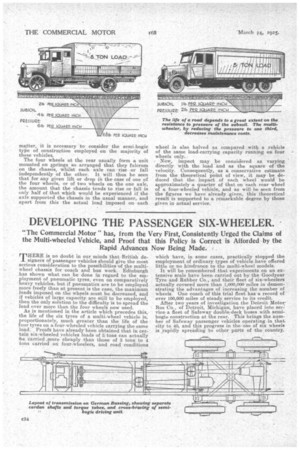'WHY RIGID SIX WHEEI :30NSERVE THE ROADS.
Page 16

Page 17

Page 18

If you've noticed an error in this article please click here to report it so we can fix it.
An Analysis of the Comparative Perform Shows the Remaikable Advantages Obtai
ur-Wheeledand Six-wheeled Vehicles which Use 'of Semi-bogie Multi-wheel Construction. THE ROAD engineers of every civilized country in the world are greatly exercised in their minds at the vast increase in the volume of motor traffic and the consequent extra wear both on surfacings and foundations. It is being realized on every hand that the science of road construction is not advancing at anything like the same speed as the giowth in road usage, and that the cost of building and upkeep—always great—is likely to reach critical limits unless something be done to alleviate the situation. It will soon be necessary either to build roads which will possess a greater potential life, or to reduce the factor of road wear per vehicle.
Methods of Limiting Road Wear.
As matters stand, it would appear that road foundations have almost reached the limit of their aevelopment, so far as the materials employed and their actual construction are concerned, and it is, therefore, most essential that careful attention be given to the second method of solving the problem. It may be done partially by the more extensive employment of pneumatic tyres, even on the heavier classes of vehicle, but in our opinion, still more is to be said for multi-wheel construction.
Very little work in the latter direction has so far been carried out in this country and we believe that, if careful tests were conducted by the Ministry of Transport, its eyes would be opened to the great potentialities presented by the use of more than four wheels.
In certain parts of the United States of America The road conditions are even more difficult than here, and legislation to restrict the damage done to highways by heavily laden four-wheeled vehicles, is imminent. Consequently, the results of extensive tests made some little time ago by the United States Bureau of Roads will certainly be of considerable interest. Of these tests, the most important are, we consider, those concerning impact, and one of our . diagrams gives a graphical comparison of the HU-pact, with different sizes and types of vehicle equipped with solid or pneumatic tyres.
Each test was carried out at a speed of 17.5 m.p.h., the vehicle being driven over an obstruction 2 ins. high. A 2-ton four-wheeler with a 2-ton load and solid tyres gave an impact figure of 21,900 lb. ; with pneumatic tyres on the same vehicle, this. was reduced to 7,300 lb. A 5-ton four-wheeler with dual solids at the rear and carrying a 5-ton load, gave the high impact figure of 29,000 lb. ; when fitted with pneumatics and carrying a s-ton load, the figure was reduced to 11,900 lb. „In the case of a six-wheeler on pneumatics and with an 8i-ton load. the remarkably low figure of 7,000 lb. was obtained, and a study of these results will show that the six wheeler, with more than four times the load of the 2-ton vehicle on pneumatics, actually gave an im pact figure of 300 lb. less.
Impact, however, is not the only factor which must be considered. Many roads are not provided with foundations which will adequately resist the weights imposed by heavy vehicles, unless these weights be distributed over a large area, and the second graph which we reproduce shows the comparative pressures on the subsoil of two vehicles equally laden, but one on four solid-tyred wheels and the other with six wheels equipped with pneumatics. In each case the deadweight over the rear axle or axles was the same.
The results showed that the four-wheeled vehicle exerted a maximum pressure of 64 lb. per sq. in., whilst in the ease of the six-wheeler this pressure was reduced to 2 lb. per sq. in. These results are of particular interest, in that the weakest subsoil known has a supporting power of just 2 lb. per sq.
in., not nearly enough for the four-wheeled vehicle, but sufficient to carry the six-wheeler.
In this article we are considering the question of road damage and methods for its -prevention, rather than the effect of road vibration on the vehicle, but it must be remembered that action and reaction are equal and opposite, and if the roads be damaged there is no doubt that vehicles are also suffering deleterious effects, and what will save the road will both save the vehicle and promote the comfort of
the passengers or the safety of the freight. . .
How Multi-wheelers Save Tyres.
Further tests by the U.S.A. Government have shown that a 5-ton load can be carried as far on one set of six pneumatic tyres as on two complete sets of four. This means a saving of some 25 per cent. in the consumption of rubber, and as the wear on a tyre must bear a certain ratio to the wear on the road, this factor alone proves that that on the road must be decreased by the same amount.
At least a small portion of the wear on road surfaces can be attributed to the effects of braking, and if this braking can be distributed over a larger area it will be all to the good. If considered purely in its relation to the vehicle, the extra braking power is really remarkable. It has been shown that the braking deceleration on a four-wheeler is about 8 ft. per sec. per sec. at the best, with 7 ft per see. per sec. as an average, whereas in the case of .a sixwheeler, braking on the four driving wheels only, the deceleration is approximately 16 ft. per sec. per Sec.
It may at first be difficult to realize why the sixwheeler should give such remarkable results in the
reduction.' of imnaet Fully to understand the•
matter, it is necessary to consider the semi-bogie type of construction employed on the majority of these vehicles.
The four wheels at the rear usually form a unit mounted on prings so arranged that they fulcrum on the chassis, whilst each axle can rise or fall independently of the other. It will thus be seen that for any given lift or drop in the case of one Of the four wheels, or of two wheels on the one axle, the amount that the chassis tends to rise or fall is only half of that which would be experienced if the axle supported the chassis in the usual manner, and apart from this the actual load imposed on each
wheel is also halved as compared with a vehicle of the same load-carrying capacity running on four wheels only..
Now, impact may be considered as varying directly with the load and as the square of the velocity. Consequently, as a conservative estimate from the theoretical point of view, it may be deduced that the impact of each wheel would be approximately a quarter of that on each rear wheel of a four-wheeled vehicle, and as will be seen from the figures we have already given, this theoretical result is supported to a remarkable degree by those given in actual service.
























































